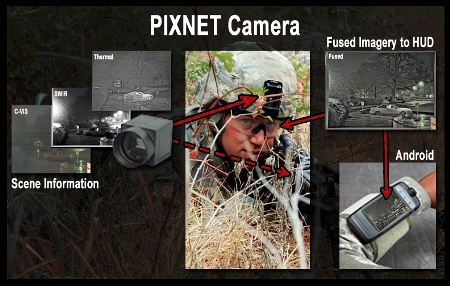Nov 6 2012
It is often the case with new military technologies that warfighters need to adjust to their equipment to access needed capabilities. As missions shift, however, and warfighters are required to work in smaller teams and access more remote locations, it is technology that must adapt if it is to remain useful. Desirable features for many new man-portable systems include small size, light weight, minimal power consumption, low cost, ease of use, multi-functionality and, to the extent possible, network friendliness.
 PIXNET Camera
PIXNET Camera
DARPA created the Pixel Network for Dynamic Visualization program, or PIXNET, to apply these features to the cameras and sensors used by dismounted warfighters and small combat units for battlefield awareness and threat detection and identification. PIXNET aims to develop helmet-mounted and clip-on camera systems that combine visible, near infrared, and infrared sensors into one system and aggregate the outputs. PIXNET technology would ingest the most useful data points from each component sensor and fuse them into a common, information-rich image that can be viewed on the warfighter’s heads-up display, and potentially be shared across units.
The base technologies DARPA proposes to use already exist and are currently used by warfighters. However, these devices typically have dedicated functionality, operate independently of one another and provide value only to the immediate operator. Through PIXNET, DARPA seeks to fuse the capabilities of these devices into a single multi-band system, thus alleviating physical overburdening of warfighters, and develop a tool that is network-ready, capable of sharing imagery with other warfighters.
“Existing sensor technologies are a good jumping-off point, but PIXNET will require innovations to combine reflective and thermal bands for maximum visibility during the day or night, and then package this technology for maximum portability. What we really need are breakthroughs in aperture design, focal plane arrays, electronics, packaging and materials science,” said Nibir Dhar, DARPA program manager for PIXNET. “Success will be measured as the minimization of size, weight, power and cost of the system and the maximization of functionality.”
To help boost processing power while minimizing size and energy use, PIXNET sensors will interface wirelessly with an Android-based smart phone for fusing images and for networking among units. Although the primary focus of PIXNET is on sensor development, proposers are instructed to develop whatever apps are necessary to achieve the desired functionality for phone and camera.
In addition to technological innovation, proposers are encouraged to develop plans for transitioning the low-cost camera system into manufacturing. In the case of the helmet-mounted system, DARPA’s preferred cost goal in a manufacturing environment producing 10,000 units per month is $3,300 per unit.